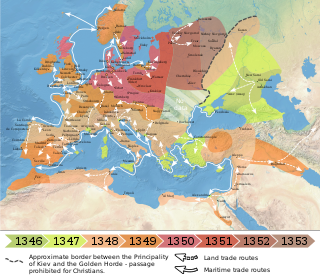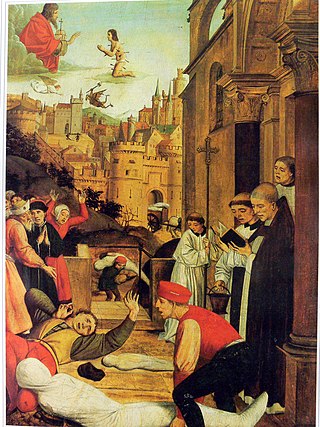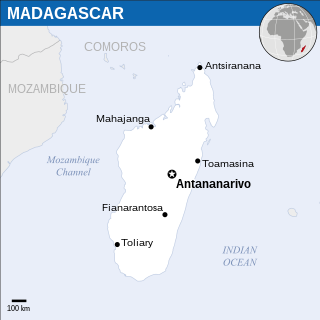Related Research Articles

The Black Death was a bubonic plague pandemic that occurred in Europe from 1346 to 1353. It was one of the most fatal pandemics in human history; as many as 50 million people perished, perhaps 50% of Europe's 14th century population. The disease is caused by the bacterium Yersinia pestis and spread by fleas and through the air. One of the most significant events in European history, the Black Death had far-reaching population, economic, and cultural impacts. It was the beginning of the second plague pandemic. The plague created religious, social and economic upheavals, with profound effects on the course of European history.

Plague is an infectious disease caused by the bacterium Yersinia pestis. Symptoms include fever, weakness and headache. Usually this begins one to seven days after exposure. There are three forms of plague, each affecting a different part of the body and causing associated symptoms. Pneumonic plague infects the lungs, causing shortness of breath, coughing and chest pain; bubonic plague affects the lymph nodes, making them swell; and septicemic plague infects the blood and can cause tissues to turn black and die.

Yersinia pestis is a gram-negative, non-motile, coccobacillus bacterium without spores that is related to both Yersinia enterocolitica and Yersinia pseudotuberculosis, the pathogen from which Y. pestis evolved and responsible for the Far East scarlet-like fever. It causes the disease plague, which caused the Plague of Justinian and the Black Death, the deadliest pandemic in recorded history. Plague takes three main forms: pneumonic, septicemic, and bubonic. It is a facultative anaerobic organism that can infect humans primarily via the Oriental rat flea, but also through airborne droplets for its pneumonic form. Yersinia pestis is a parasite of its host, the rat flea, which is also a parasite of rats, hence Y. pestis is a hyperparasite.

Pneumonic plague is a severe lung infection caused by the bacterium Yersinia pestis. Symptoms include fever, headache, shortness of breath, chest pain, and coughing. They typically start about three to seven days after exposure. It is one of three forms of plague, the other two being septicemic plague and bubonic plague.

Septicemic plague is one of the three forms of plague, and is caused by Yersinia pestis, a gram-negative species of bacterium. Septicemic plague is a systemic disease involving infection of the blood and is most commonly spread by bites from infected fleas. Septicemic plague can cause disseminated intravascular coagulation and is always fatal when untreated. The other varieties of the plague are bubonic plague and pneumonic plague.

The plague of Justinian or Justinianic plague was an epidemic that afflicted the entire Mediterranean Basin, Europe, and the Near East, severely affecting the Sasanian Empire and the Byzantine Empire, especially Constantinople. The plague is named for the Byzantine Emperor Justinian I, who according to his court historian Procopius contracted the disease and recovered in 542, at the height of the epidemic which killed about a fifth of the population in the imperial capital. The contagion arrived in Roman Egypt in 541, spread around the Mediterranean Sea until 544, and persisted in Northern Europe and the Arabian Peninsula until 549. By 543, the plague had spread to every corner of the empire. As the first episode of the first plague pandemic, it had profound economic, social, and political effects across Europe and the Near East and cultural and religious impact on Eastern Roman society.

The third plague pandemic was a major bubonic plague pandemic that began in Yunnan, China, in 1855. This episode of bubonic plague spread to all inhabited continents, and ultimately led to more than 12 million deaths in India and China, and at least 10 million Indians were killed in British Raj India alone, making it one of the deadliest pandemics in history. According to the World Health Organization, the pandemic was considered active until 1960, when worldwide casualties dropped to 200 per year. Plague deaths have continued at a lower level for every year since.

The Great Plague of Vienna occurred in 1679 in Vienna, Austria, the imperial residence of the Austrian Habsburg rulers. From contemporary descriptions, the disease is believed to have been bubonic plague, which is caused by the bacterium Yersinia pestis, carried by fleas associated with the black rat and other rodents. The city was crippled by the epidemic, which recurred fitfully into the early 1680s, claiming an estimated 76,000 residents.
John Ashburton Thompson was a British-Australian physician and an international authority on plague and leprosy.
Globalization, the flow of information, goods, capital, and people across political and geographic boundaries, allows infectious diseases to rapidly spread around the world, while also allowing the alleviation of factors such as hunger and poverty, which are key determinants of global health. The spread of diseases across wide geographic scales has increased through history. Early diseases that spread from Asia to Europe were bubonic plague, influenza of various types, and similar infectious diseases.

Bubonic plague is one of three types of plague caused by the bacterium Yersinia pestis. One to seven days after exposure to the bacteria, flu-like symptoms develop. These symptoms include fever, headaches, and vomiting, as well as swollen and painful lymph nodes occurring in the area closest to where the bacteria entered the skin. Acral necrosis, the dark discoloration of skin, is another symptom. Occasionally, swollen lymph nodes, known as "buboes", may break open.
Theories of the Black Death are a variety of explanations that have been advanced to explain the nature and transmission of the Black Death (1347–51). A number of epidemiologists from the 1980s to the 2000s challenged the traditional view that the Black Death was caused by plague based on the type and spread of the disease. The confirmation in 2010 and 2011 that Yersinia pestis DNA was associated with a large number of plague sites has led researchers to conclude that "Finally, plague is plague."

The second plague pandemic was a major series of epidemics of plague that started with the Black Death, which reached medieval Europe in 1346 and killed up to half of the population of Eurasia in the next four years. It followed the first plague pandemic that began in the 6th century with the Plague of Justinian, but had ended in the 8th century. Although the plague died out in most places after 1353, it became endemic and recurred regularly. A series of major epidemics occurred in the late 17th century, and the disease recurred in some places until the late 18th century or the early 19th century. After this, a new strain of the bacterium gave rise to the third plague pandemic, which started in Asia around the mid-19th century.

The San Francisco plague of 1900–1904 was an epidemic of bubonic plague centered on San Francisco's Chinatown. It was the first plague epidemic in the continental United States. The epidemic was recognized by medical authorities in March 1900, but its existence was denied for more than two years by California's Republican governor Henry Gage. His denial was based on business reasons, to protect the reputations of San Francisco and California and to prevent the loss of revenue due to quarantine. The failure to act quickly may have allowed the disease to establish itself among local animal populations. Federal authorities worked to prove that there was a major health problem, and they isolated the affected area; this undermined Gage's credibility, and he lost the governorship in the 1902 elections. The new governor, George Pardee, implemented public-health measures and the epidemic was stopped in 1904. There were 121 cases identified, resulting in 119 deaths.

Sylvatic plague is an infectious bacterial disease caused by the plague bacterium that primarily affects rodents, such as prairie dogs. It is the same bacterium that causes bubonic and pneumonic plague in humans. Sylvatic, or sylvan, means 'occurring in woodland,' and refers specifically to the form of plague in rural wildlife. Urban plague refers to the form in urban wildlife.

The 1924 Los Angeles pneumonic plague outbreak was an outbreak of the pneumonic plague in Los Angeles, California that began on September 28, 1924, and was declared fully contained on November 13, 1924. It represented the first time that the plague had emerged in Southern California since plague outbreaks had previously surfaced in San Francisco and Oakland. The suspected reason for this outbreak was a rat epizootic where squirrels that were found to be plague infected were secondarily infected by rats. Due to the evidence of infected squirrels near San Luis Obispo County as late as July 1924 and the migration habits of both squirrels and rats, it is thought that squirrels were the original source of the plague outbreak in Los Angeles.

Madagascar has experienced several outbreaks of bubonic and pneumonic plague in the 21st century. In the outbreak beginning in 2014, 71 died; in 2017, 202 died. Smaller outbreaks occurred in January 2008, and December 2013.
Globally about 600 cases of plague are reported a year. In 2017 and November 2019 the countries with the most cases include the Democratic Republic of the Congo, Madagascar, and Peru.

The 1894 Hong Kong plague, part of the third plague pandemic, was a major outbreak of the bubonic plague in Hong Kong. While the plague was harshest in 1894, it returned annually between 1895 and 1929, and killed over 20,000 in total, with a fatality rate of more than 93%. The plague was a major turning point in the history of colonial Hong Kong, as it forced the colonial government to reexamine its policy towards the Chinese community, and invest in the wellbeing of the Chinese.

The Great Hanoi Rat Massacre occurred in 1902, in Hanoi, Tonkin, French Indochina, when the French government authorities attempted to control the rat population of the city by hunting them down. As they felt that they were making insufficient progress, and due to labour strikes, they created a bounty programme that paid a reward of 1¢ for each rat killed. To collect the bounty, people would need to provide the severed tail of a rat. Colonial officials, however, began noticing rats in Hanoi with no tails. The Vietnamese rat catchers would capture rats, sever their tails, then release them back into the sewers so that they could produce more rats.
References
- 1 2 Centers for Disease Control Prevention (CDC) (21 October 1994). "International Notes Update: Human Plague—India, 1994". MMWR Morb. Mortal. Wkly. Rep. 43 (41): 761–762. PMID 7935308 . Retrieved 26 December 2015.
- ↑ Staff, EID Editorial (July–August 2001). "In Memoriam: Vulimiri Ramalingaswami (1921–2001)" (PDF). Emerging Infectious Diseases. 7 (4): 766. doi: 10.3201/eid0704.010440 . Retrieved 25 November 2011.
- ↑ Ramalingaswami V (December 2001). "Psychosocial effects of the 1994 plague outbreak in Surat, India". Mil Med. 166 (12 Suppl): 29–30. doi: 10.1093/milmed/166.suppl_2.29 . PMID 11778425.
- 1 2 Hazarika, Sanjoy (14 March 1995). "Plague's Origins A Mystery". The New York Times. Retrieved 31 October 2009.
- 1 2 3 Basu, Mohana (14 March 2020). "1994 Surat plague has many lessons for India on how to beat coronavirus". ThePrint. Retrieved 27 March 2021.
- ↑ Saxena, Vijay K., and T. Verghese. "Ecology of Flea-Transmitted Zoonotic Infection in Village Mamla, District Beed". Current Science, vol. 71, no. 10, 1996, pp. 800–802. JSTOR, www.jstor.org/stable/24098741. Accessed 1 July 2020.
- 1 2 "WHO/CDS/CSR/EDC/99.2 Plague ManualEpidemiology, Distribution, Surveillance and Control" (PDF). World Health Organization. p. 35. Archived (PDF) from the original on 16 July 2020.
- ↑ "Surat: A Victim of Its Open Sewers". The New York Times. 25 September 1994. Retrieved 26 April 2008.
- ↑ Armstrong, Dorsey (21 September 2017). "The Black Death: Is The Plague Still A Threat?". The Great Courses Daily. Archived from the original on 2 July 2020. Retrieved 27 March 2021.
- 1 2 Burns, John F. (29 September 1994). "With Old Skills and New, India Battles the Plague". The New York Times . Retrieved 31 October 2009.
- ↑ Joseph Patrick Byrne, ed. (2008). Encyclopedia of pestilence, pandemics, and plagues. Westport, Conn.: Greenwood Press. pp. 542–543. ISBN 978-0-313-34101-4. OCLC 226357719.
- 1 2 3 4 5 "The Surat Plague and its Aftermath". montana.edu. Godshen Robert Pallipparambil. Archived from the original on 11 June 2010. Retrieved 26 April 2008.
- ↑ Dutt, Ashok (July 2006). "Surat Plague of 1994 Re-Examined" (PDF). Review. 37 (4): 755–760. PMID 17121302. Archived from the original (PDF) on 6 February 2016. Retrieved 31 October 2015.